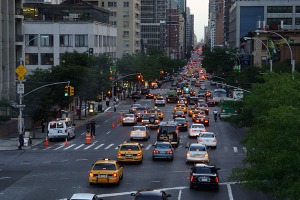Stuck in Traffic: The Failure of New York City Congestion Pricing
As is apparent even to the tourists in Times Square, Manhattan’s traffic jams are a consistent source of delays, aggravation, and air pollution. As part of 2007’s PlaNYC, the New York City government’s comprehensive vision for the future, the city proposed implementing a congestion pricing system similar to those in place in London and Singapore. The goal was to ease the flow of traffic, encourage the use of public transportation, and nudge residents towards more sustainable patterns of everyday life.
As Patrick Lynch (MCP ’10) shows in his thesis, the city’s congestion pricing plans were initially promising. Proponents had strong support from residents, state politicians, and the federal government. However, implementation died in the New York State Assembly, which refused to even vote on the measure. Patrick notes several reasons for this, including a byzantine program approval process and disagreement over how revenues should be spent.
The biggest problem with congestion pricing, however, was the conflict between winners and losers. While the measure enjoyed the support of local politicians in Manhattan and the Bronx, representatives of the city’s other boroughs felt that their constituents were being unjustly targeted. Proponents did little to address these concerns, and they did a poor job of building a supportive coalition to counter their opponents. Ultimately, opposition from a politically important and geographically concentrated bloc created a hostile political climate and doomed efforts for congestion pricing in the city.
Read Patrick’s conclusions about New York City’s failure to implement congestion pricing and his thoughts on implementation of related schemes elsewhere in his thesis.
Posted on April 3, 2013, in gas, transportation, Uncategorized, urban planning. Bookmark the permalink. 1 Comment.

birkenstock sales